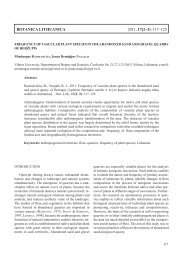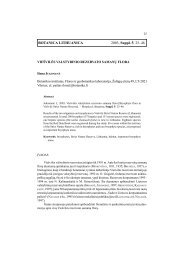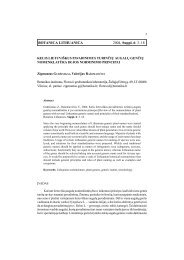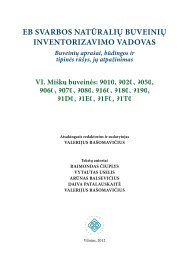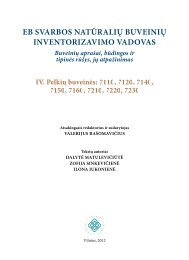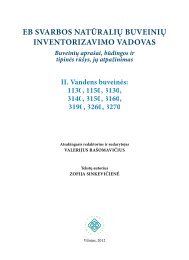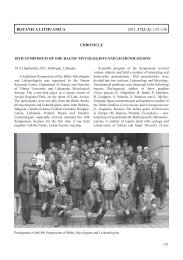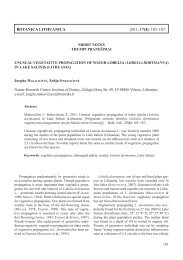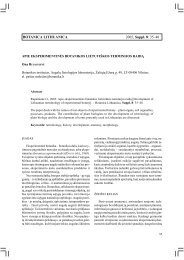FUNGI AND LICHENS IN THE BALTICS AND BEYOND XVIII ...
FUNGI AND LICHENS IN THE BALTICS AND BEYOND XVIII ...
FUNGI AND LICHENS IN THE BALTICS AND BEYOND XVIII ...
Create successful ePaper yourself
Turn your PDF publications into a flip-book with our unique Google optimized e-Paper software.
pathogen of shoots, and was detected in 9 plantations. Pathogen does not always cause the<br />
death of infected shoots at the first year, but survives, and can be presented in two-tree years<br />
olds shoots and weaken them. The most susceptible blueberry varieties to Godronia canker<br />
under Latvia conditions are ‘Bluecrop’ and ‘Blue Ray’.<br />
Other fungi were isolated from shoots – Nectria cinnabarina, Allantophomopsis spp.,<br />
Discosia artocreas, Pestalotia vaccinii, Epicoccum spp., Phyllosticta spp., also Alternaria<br />
spp. and Fusarium spp., from leaves – Gloeosporium minus. Further investigations and<br />
observations will be performed in 2011, during harvest time.<br />
PATHOGENIC FUNGAL DISEASES OF BRANCHES OF ASH <strong>IN</strong> DRY<strong>IN</strong>G OUT<br />
PLANTATIONS <strong>IN</strong> BELARUS<br />
V. B. ZVYAG<strong>IN</strong>TSEV 1* , O. Yu. BARANOV 2 , L. F. МELNIK 1<br />
1 Belarusian State Technological University, Sverdlova Str. 13a, 220006 Minsk, Belarus<br />
2 Forest Research Institute, Proletarskaya Str. 71, 246001 Homel, Belarus<br />
*E-mail: mycolog@tut.by<br />
The beginning of widespread dieback of common ash (Fraxinus excelsior) was first<br />
recorded by National Forest Monitoring Network in Belarus in 2003 (Zvyagintsev &<br />
Sazonov, 2005). To date, more than 90% of ash stands have been damaged. The symptoms of<br />
disease are shoot and branch dieback, wilting, leaf and bark lesions, formation of secondary<br />
crown, presence of significant signs of bark beetle (Hylesinus sp.) infestation, detection of<br />
root, root-collar and butt rot caused by Armillaria cepistipes и A. borealis. Affected trees have<br />
been declining gradually during several years, and were prone to windfall (Zvyagintsev,<br />
Sazonov, 2007). Similar symptoms were observed in almost all affected stands of common<br />
ash in Belarus. The necrotrophic fungus Chalara fraxinea has been previously recognized by<br />
a large number of researchers (Kowalski, 2006; Halmschlager, Kirisits, 2008; Kowalski,<br />
Holdenrieder, 2008) as the main causative agent of common ash dieback in different parts of<br />
Europe.<br />
In summer 2010, new symptoms in the form of multiple necrotic spots were observed<br />
on the twigs of decline trees from central and south regions of Belarus.<br />
Three pathogenic species were isolated on malt extract agar (MEA) from surface of<br />
small sterilized pieces of the affected twigs and incubated at 24 o C in the dark. Colonies had<br />
different morphology and growth features.<br />
Molecular analysis showed that the internal transcribed spacer (ITS) sequences of the<br />
ribosomal DNA (rDNA) of fungal isolates were identical to samples of Chalara fraxinea,<br />
Neofabraea alba and Phaeoacremonium sp. from NCBI GenBank database. Nucleotide<br />
sequences from each species were submitted to Genbank (Accession numbers JF342718,<br />
JF342719, JF342720).



